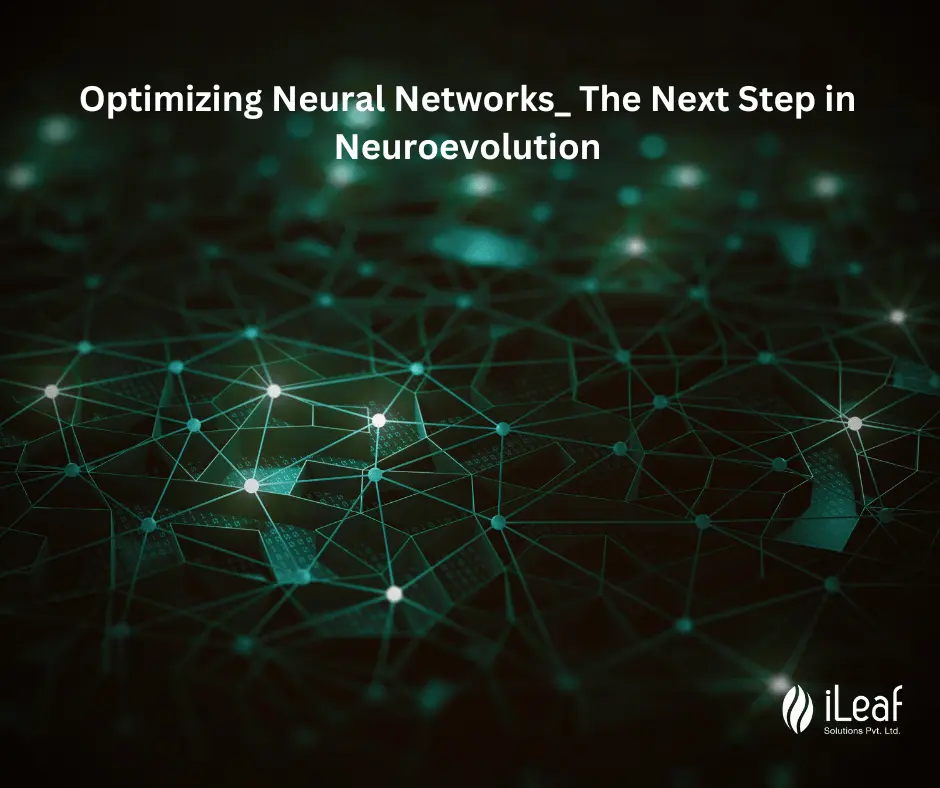Neuroevolution: Advancing Neural Networks with Genetic Algorithms

Introduction: The Evolution of Neural Networks
Neuroevolution, the combination of artificial intelligence and evolutionary algorithms, has seen significant advancements in recent years. One of the key areas of focus has been optimizing neural networks, which are used as the basis for many AI applications. As neural networks become increasingly complex, finding ways to improve their performance and efficiency becomes crucial. In this article, we will explore the next steps in neuroevolution and how researchers are working to optimize neural networks for improved AI capabilities.
Understanding the Importance of Optimization
Optimizing neural networks is essential for improving the performance and efficiency of AI applications. As neural networks become more complex, they require more computational power and resources, which can be a significant challenge. By optimizing neural networks, researchers aim to reduce the computational burden while enhancing the accuracy and speed of AI systems. Optimization plays a vital role in AI development as it allows neural networks to learn and adapt more efficiently. By fine-tuning the network's parameters and structure, researchers can maximize its capabilities, leading to more accurate predictions, faster training times, and improved overall performance. Moreover, optimizing neural networks contributes to the scalability of AI systems. As AI applications become more prevalent and demanding, the ability to efficiently and effectively optimize neural networks will become increasingly important.
In the following sections, we will delve deeper into the techniques and strategies used for optimizing neural networks and explore how these advances in neuroevolution are revolutionizing the field of AI. Stay tuned for more on this exciting topic!
Enhancing Performance through Hyperparameter Tuning
One of the key techniques used for optimizing neural networks is hyperparameter tuning. Hyperparameters are the configuration settings that determine the behavior and performance of the neural network. These parameters cannot be learned directly from the data but need to be set by the researcher. Hyperparameter tuning involves systematically adjusting the hyperparameters to find the optimal values that maximize the performance of the network. This process is often iterative and involves trying different combinations of hyperparameter values, training the network, and evaluating its performance. Common hyperparameters that are often tuned include learning rate, batch size, activation functions, regularization techniques, and network architecture. By optimizing these hyperparameters, researchers can achieve significant improvements in the performance and efficiency of the neural network. In the next section, we will explore various techniques and strategies used for hyperparameter tuning and discuss their impact on neural network optimization. Stay tuned to uncover the key insights that can take your AI applications to the next level!
Leveraging Advanced Techniques for Weight Initialization
While hyperparameter tuning can greatly enhance the performance of neural networks, another crucial aspect of optimization lies in weight initialization. The weights of a neural network determine the strength of connections between neurons and play a vital role in network behavior. Traditionally, the weights of a neural network are initialized randomly, which might lead to suboptimal network performance. However, advanced techniques for weight initialization have emerged that aim to improve the convergence speed and overall performance of the network. One such technique is the Xavier initialization, which sets the initial weights using a specific statistical distribution based on the number of input and output neurons. Another popular technique is the He initialization, particularly effective for networks that use ReLU activation functions. In the next section, we will delve into these advanced weight initialization techniques and discuss how they can be leveraged to optimize neural network performance. Stay tuned as we unravel the secrets to achieving even greater results in neuroevolution!
Unleashing the Power of Regularization in Neural Networks
Now that we have explored advanced techniques for weight initialization, let's move on to another crucial aspect of optimizing neural networks: regularization techniques. Regularization plays a key role in preventing overfitting and improving the generalization ability of neural networks. Overfitting occurs when a neural network learns the training data too well, resulting in poor performance on unseen data. Regularization techniques help mitigate this issue by introducing an additional term to the loss function, which adds a penalty for complex models. One of the most popular regularization techniques is L2 regularization, also known as weight decay. It adds a term that encourages smaller weights, preventing the model from relying too heavily on a few particular features. Another powerful technique is dropout, where random neurons are temporarily "dropped out" during training, forcing the network to learn robust representations. In the upcoming section, we will dive into the details of these regularization techniques and examine how they can be effectively utilized to optimize neural network performance. Get ready to unlock the full potential of your neural networks through the power of regularization! Stay tuned!
Exploiting Advanced Activation Functions for Improved Results
Now that we have discussed the importance of regularization techniques in optimizing neural networks, it's time to focus on another key aspect - activation functions. Activation functions are the mathematical operations that determine the output of a neuron. They play a crucial role in introducing non-linearities into the network, enabling it to learn complex patterns and make accurate predictions. While traditional activation functions like sigmoid and tanh have been widely used, recent advancements have introduced more advanced functions that offer improved performance. One such function is the Rectified Linear Unit (ReLU), which has gained popularity due to its simplicity and ability to mitigate the vanishing gradient problem. Other activation functions like Leaky ReLU, ELU, and Swish have also shown promising results in enhancing network performance. In the upcoming section, we will delve into these advanced activation functions, their advantages, and how they can be utilized to further optimize neural network training. Don't miss out on uncovering the potential of these activation functions to achieve improved results in your neural networks!
The Role of Optimizers in Neural Network Training
In our journey to optimize neural networks, we have explored regularization techniques and advanced activation functions. However, there is yet another crucial element that can significantly impact the performance of our models - optimizers. Optimizers are algorithms that adjust the weights and biases of a neural network during training, aiming to minimize the error or loss function. They help in finding the optimal set of parameters that can lead to accurate predictions and efficient learning. Traditional optimizers like Stochastic Gradient Descent (SGD) have been widely used, but newer variants have emerged to address their limitations. Some notable examples include Adam, RMSprop, and AdaGrad, which incorporate adaptive learning rates and momentum to converge faster and improve generalization. In the upcoming section, we will dive into these popular optimizers, discuss their strengths, and guide you in selecting the right one for your neural network. Stay tuned to unlock the potential of optimizers in maximizing the effectiveness of your neuroevolution journey.
The Impact of Network Architecture on Neuroevolution
Now that we have delved into the world of optimizers and their significance in neural network training, it's time to shift our focus to another crucial aspect of neuroevolution - network architecture. The architecture of a neural network refers to the arrangement and connectivity of its layers and neurons. It plays a pivotal role in determining the network's capacity to learn, its computational efficiency, and its ability to generalize to unseen data. Various factors influence network architecture, such as the number of hidden layers, the number of neurons in each layer, and the type of connections between layers. Different network architectures have different strengths and limitations, making it essential to choose the right one for your specific problem. In the next section, we will explore different types of network architectures commonly used in neuroevolution, including feedforward networks, convolutional neural networks (CNNs), recurrent neural networks (RNNs), and more. We will discuss their characteristics, applications, and provide insights on selecting the most suitable architecture for your neuroevolution journey.
So stay tuned as we dive into the fascinating world of neural network architectures, and unlock the potential they hold in revolutionizing neuroevolution.
Utilizing Transfer Learning to Boost Neural Network Performance
As we continue our exploration of optimizing neural networks in neuroevolution, we come across another powerful technique - transfer learning. Transfer learning allows us to benefit from the knowledge acquired by pre-trained models on similar tasks or datasets, and apply it to new tasks. By leveraging transfer learning, we can accelerate the training process and improve the performance of our neural networks. Instead of starting from scratch, we can initialize our network with pre-trained weights and fine-tune it based on our specific problem. This approach is especially beneficial when we have limited training data or computational resources. It not only saves time and resources but also helps to overcome the challenges of training large, complex networks from scratch. In the next section, we will delve into transfer learning and explore its potential in boosting the performance of neural networks in neuroevolution. We will discuss the different types of transfer learning, the steps involved in its implementation, and provide practical tips for achieving the best results.
So, get ready to unlock the secrets of transfer learning and take your neuroevolution journey to new heights!
Conclusion: The Promising Future of Optimized Neural Networks
In conclusion, optimizing neural networks through techniques like transfer learning is the next step in neuroevolution. Transfer learning allows us to tap into the knowledge acquired by pre-trained models, accelerating the training process and improving network performance. By leveraging transfer learning, we can overcome the challenges posed by limited data and computational resources. Instead of starting from scratch, we can initialize our network with pre-trained weights and fine-tune it based on our specific problem. In this blog series, we explored the concept of transfer learning, its types, and effective implementation steps. We also discussed practical tips for achieving the best results. As we look to the future, the potential for optimized neural networks is vast. With ongoing advancements in technology, the field of neuroevolution holds promise in solving complex problems and driving innovation across various domains. So, let us embrace the potential of optimized neural networks and continue pushing the boundaries of neuroevolution. Together, we can unlock a world of endless possibilities.














